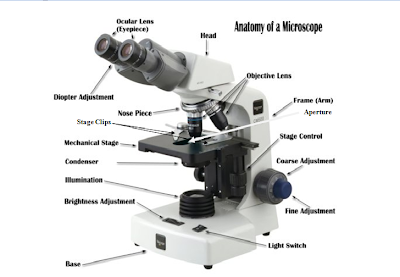Name : Marta Asri Dewi
Student
Number : 12315244009
Study
Program : Science Education
Class : International
1.
Microscope and its parts
|
|
2.
Function of each part of microscope
a.
Eyepiece:
The lens the viewer looks through to see the specimen.
b.
Diopter
Adjustment: Useful as a means to change focus on one eyepiece so as to
correct for any difference in vision between your two eyes.
c.
Body tube
(Head): The body tube connects the eyepiece to the objective lenses.
d.
Arm: The
arm connects the body tube to the base of the microscope.
e.
Coarse
adjustment: Brings the specimen into general focus.
f.
Fine adjustment:
Fine tunes the focus and increases the detail of the specimen.
g.
Nosepiece:
A rotating turret that houses the objective lenses. The viewer spins the
nosepiece to select different objective lenses.
h.
Objective
lenses: One of the most important parts of a compound microscope, as
they are the lenses closest to the specimen.
i.
Mechanical
Stage: The flat platform where the slide is placed.
j.
Stage clips:
Metal clips that hold the slide in place.
k.
Stage height
adjustment (Stage Control): These knobs move the stage left and right or
up and down.
l.
Aperture:
The hole in the middle of the stage that allows light from the illuminator to
reach the specimen.
m.
On/off switch
(Light Switch): This switch on the base of the microscope turns the
illuminator off and on.
n.
Illumination:
The light source for a microscope. Older microscopes used mirrors to reflect
light from an external source up through the bottom of the stage; however, most
microscopes now use a low-voltage bulb.
o.
Brightness
Adjustment: Adjusts the amount of light that reaches the specimen.
p.
Condenser:
Gathers and focuses light from the illuminator onto the specimen being viewed.
q.
Base:
The base supports the microscope and it’s where illuminator is located.
 RSS Feed
RSS Feed Twitter
Twitter 11:52 AM
11:52 AM
 Unknown
Unknown






0 comments:
Post a Comment